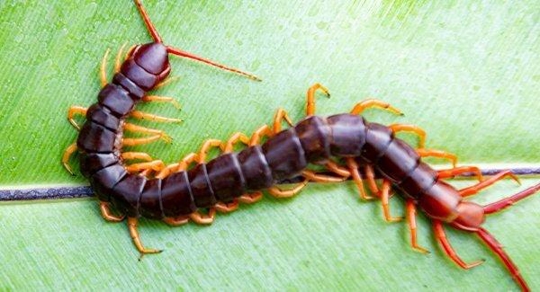Have you ever spotted a centipede or a millipede in your home? If you live in Connecticut, you probably have. While centipedes are notable for their many pairs of legs (anywhere from 15-177 pairs), they are actually infrequently seen by humans because of their nocturnal nature. Traditionally, their body is yellow to dark brown in color and sometimes have striped markings. Centipedes are also extremely slow moving, which can be both a help and a hindrance to humans looking to spot them. And while centipedes’ bites are venomous, they very rarely bite humans and pose little health risk to humans and pets.
Millipedes measure 1 to 1 1/2 inch and are dark brown in color. They are long and slinky with many pairs of legs and tend to slither in movement. Some people even say that they look like fat worms with legs. Millipedes are similarly nocturnal in nature and tend to move in large numbers, so if homeowners see one millipede, there is most likely already an infestation. Millipedes do not sting or bite, however, some of them emit a defensive fluid that can cause an allergic reaction in some people.
The Life Of Centipedes And Millipedes
Both centipedes and millipedes enter your Connecticut home in search of significant moisture. Such spots might include rotting wood, both in your home and on your property, underneath piles of leaves, inside dog houses, and underneath mulch. Once centipedes and millipedes have broken into your home, it is most likely that homeowners will find them in crawl spaces, bathrooms, basements, or attics. Some people do not view them as much of an issues, as they both tend to kill and eat other nuisance pests such as cockroaches, spiders, moths, flies, and silverfish. However, homeowners still do not want an infestation because centipedes and millipedes cause a host of other issues that are unpleasant to deal with.
Preventing Centipedes And Millipedes
Though they are different, centipedes and millipedes are often attracted for the same reasons, like the same things, and enter your home in the same ways. Here are a few tips at keeping both out of your home:
- Both centipedes and millipedes come in search of cool, wet places, so strive to reduce any sources of excess moisture both in and around your home. This may include pool coverings, leaky faucets, or other areas, big or small, where water might pool.
- Centipedes and millipedes love a cool, dark place to hide, so dispose of piles of leaves, lawn trimmings, and logs from your property before they start to accumulate.
- A key factor in preventing most nuisance pest infestations is to store your firewood at least 20 feet from your home and five inches off the ground. This is another favorite hiding spot for both centipedes and millipedes, so do not give them the option.
- Make sure that any crawl spaces, attics, and basements are properly ventilated, and check them regularly. These spaces provide centipedes and millipedes with almost everything they need and tend to be infrequently checked on by humans so they tend to live uninterrupted and infest these spaces.
- Repair any cracks, holes, or tears in your home’s foundation or points of entry.
The best way to ensure that centipedes and millipedes stay away from your property is with ongoing professional assistance from the team at Big Blue Bug Solutions. For effective pest control, contact us today!

